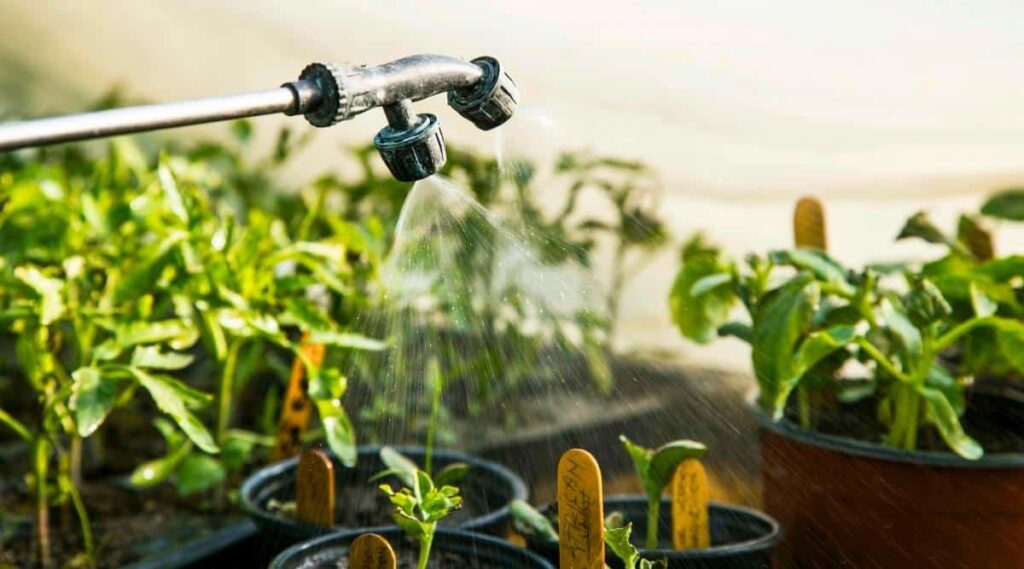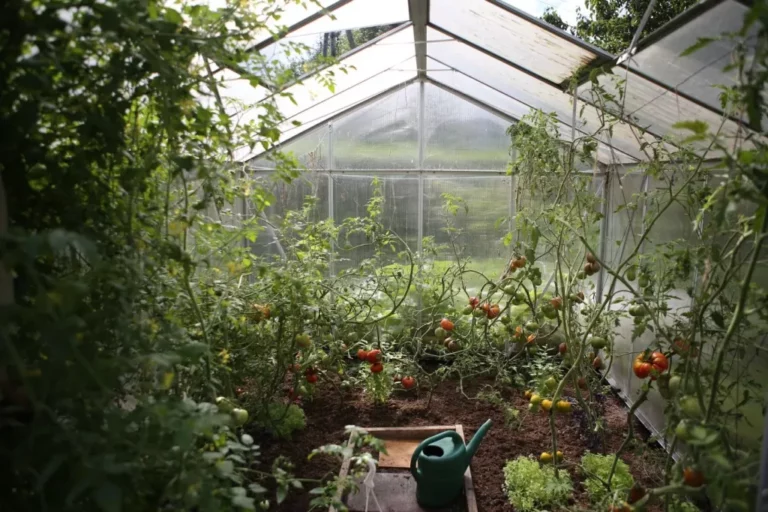Greenhouses help grow special plants in a controlled space. Some good plants for greenhouses are tomatoes, especially the fancy kinds, and peppers like bell and chili peppers. Cucumbers, especially the ones without seeds or special types, also grow well in greenhouses. People like leafy greens, herbs like basil and cilantro, and tiny, super-tasty plants called microgreens from greenhouses. Strawberries can last longer and sell for more when they’re grown in greenhouses. Where it’s allowed, growing cannabis in greenhouses can make a lot of money.
Some rare fruits like figs or passionfruit can also make good profits. To do well in greenhouse farming, it’s important to think about what people want around you, how much it costs to grow, how much you can make, and what tools you need. Keeping up with what people like to buy is also really important.
How do Climate Control and Environmental Factors Impact Greenhouses?

It’s really important for greenhouse farmers to know and handle these things well. This helps them make more money while still taking care of the environment.
Climate Control and Environmental Factors
Temperature and Humidity Control
Greenhouses allow growers to manipulate temperature and humidity levels, creating optimal conditions for different crops. Maintaining these factors within an ideal range significantly influences crop growth rates, yields, and overall quality.
Lighting
The availability and quality of light play a pivotal role in photosynthesis and plant growth. Greenhouses often employ supplemental lighting to extend daylight hours or compensate for low light conditions, impacting plant development and flowering.
Ventilation and Air Circulation
Proper airflow and ventilation prevent issues like excessive humidity, fungal diseases, and pest infestations. It also ensures an optimal CO2 level for photosynthesis, ultimately affecting crop health and yield.
Market Demand and Pricing
Market Analysis and Trends
Understanding consumer preferences, seasonal demands, and emerging market trends is crucial. Growers need to align their crop selection with high-demand produce to maximize profitability.
Price Fluctuations
Crop prices can vary due to factors such as seasonal changes, competition, and global supply chains. Being aware of these fluctuations helps growers make informed decisions about when to sell their crops for the best returns.
Local vs. Export Markets
Evaluating whether to target local markets or explore exporting opportunities impacts crop selection and pricing strategies. Local markets might have different demands than international markets, influencing profitability decisions.
Crop Yield and Growing Conditions
Optimal Growing Condition
Tailoring the greenhouse environment to suit specific crops ensures optimal growth conditions, leading to higher yields and better-quality produce.
Crop Varieties and Genetics
Selecting the right crop varieties adapted to greenhouse conditions can significantly impact yields. Disease-resistant or high-yielding varieties can enhance productivity and profitability.
Crop Rotation and Management
Proper crop rotation and management practices can mitigate soil depletion, pest buildup, and disease occurrence, maintaining a healthy growing environment and sustaining yields.
Operational Costs and Input Requirements
Energy Costs
Heating, cooling, lighting, and ventilation contribute to significant energy expenses. Efficient energy use through technology and alternative energy sources impacts operational costs.
Labor and Maintenance
Skilled labor for greenhouse operations and maintenance is essential. Efficient labor management and minimizing downtime affect operational expenses.
Input Materials
Costs related to seeds, fertilizers, pesticides, and substrates influence profitability. Efficient use and selection of high-quality inputs impact crop health and yield.
What Makes Crops Profitable in Controlled Environments?
Thinking about these things carefully helps greenhouse farmers choose plants that match what people want to buy. These plants should grow well in controlled spaces, grow quickly, need only a little resources, and be strong against bugs and sickness. This helps farmers make the most money they can.
High-Value Crops and Market Trends
Market Demand and Pricing
High-value crops are those in demand, commanding premium prices in the market. This demand can be influenced by factors such as changing consumer preferences, health trends, or culinary fashions.
Niche or Specialty Crops
Identifying niche or specialty crops that have high demand and limited supply can offer a competitive edge. These crops often fetch higher prices due to their uniqueness or health benefits.
Suitability for Controlled Environments
Adaptability to Controlled Conditions
Certain crops thrive in controlled environments, such as greenhouses, where factors like temperature, humidity, and light can be regulated. Crops that respond well to these conditions are ideal for maximizing yields and quality.
Temperature and Humidity Tolerance
Crops that can tolerate variations in temperature and humidity within the greenhouse while still maintaining growth and productivity are preferred for controlled environments.
Short Growth Cycles and Frequent Harvests
Fast-Growing Varieties
Crops with shorter growth cycles allow for more frequent harvests within a given timeframe, enabling growers to generate revenue more quickly.
Succession Planting
Selecting crops that allow for staggered planting and harvesting schedules can ensure a continuous and consistent supply, optimizing profitability.
Low Input and Maintenance Requirements
Minimal Water and Nutrient Needs
Crops that require less water and nutrient inputs without compromising yield and quality are advantageous for reducing operational costs.
Pest and Disease Resistance
Plants that are naturally resistant or less susceptible to common pests and diseases minimize the need for pesticides and intensive management practices, reducing input costs.
Resilience to Pest and Disease Management
Some crops possess natural defense mechanisms or compounds that repel pests or diseases, reducing the reliance on chemical interventions.
Crops that support companion planting or fit well into IPM strategies, reducing the risk of pest outbreaks and simplifying management practices, are preferable for greenhouse cultivation.
What Are the Best Crops for Profitable Greenhouse Farming?

Several crops can be profitable for greenhouse farming, depending on various factors such as market demand, climate, and region.
High-Value Vegetables
Tomatoes
Tomatoes are among the most consumed vegetables globally, ensuring consistent market demand throughout the year. Different tomato varieties cater to diverse culinary needs, allowing growers to target specific markets.
Properly managed tomato plants can yield abundant fruits, maximizing profitability per
square meter in a greenhouse.
Peppers
Peppers, including bell peppers and chili peppers, have a steady demand due to their versatile use in various cuisines. Greenhouses extend the growing season for peppers, allowing for year-round production and capitalizing on off-season market opportunities.
Specialty and colorful pepper varieties often fetch higher prices, attracting niche markets and
enhancing profitability.
Cucumbers
Cucumbers thrive in controlled environments, yielding substantial quantities within a short time frame. With cucumbers being a staple in salads and as snacks, there’s a year-round demand, especially for greenhouse-grown, high-quality produce.
Vertical growing techniques can optimize space utilization, increasing yield per square meter.
Leafy Greens (Lettuce, Spinach, Kale)
Leafy greens have short growth cycles, allowing for frequent harvests and rapid turnover of crops. Increased consumer focus on healthy eating habits has elevated the demand for fresh, pesticide-free greens, particularly those grown in controlled environments.
Different types of lettuce, spinach, and kale provide opportunities to cater to varied tastes and preferences.
Herbs and Specialty Crops
Basil
Basil is a popular culinary herb with consistent demand, especially for fresh, flavorful varieties. Rapid growth and relatively low maintenance make basil a profitable greenhouse crop.
Different basil varieties (sweet, Thai, lemon) cater to diverse culinary needs, expanding market reach.
Microgreens
Microgreens fetch premium prices due to their concentrated flavors, nutritional value, and visual appeal, making them highly profitable per square foot.
Quick turnaround from seeding to harvest allows for frequent cropping and sales, maximizing profitability.
Diverse options in microgreens offer opportunities to cater to niche markets and high-end restaurants.
Saffron
Saffron is the most expensive spice globally, and greenhouse cultivation offers controlled conditions ideal for its growth.
Greenhouses can create a suitable environment for saffron cultivation even in non-native regions
FAQ’s
Which cash crop is most profitable?
The profitability of cash crops varies based on factors like location, market demand, and cultivation techniques. Some highly profitable cash crops include cannabis, saffron, and vanilla.
What is the average profit of a greenhouse?
The average profit of a greenhouse can differ widely based on the size, location, crop type, and management practices. Generally, greenhouse profits can range from a few thousand to several hundred thousand dollars annually.
Which crop has the highest demand?
Crops with high demand often include staples like rice, wheat, and maize for food security, while others like coffee, cocoa, and avocados have strong global markets due to their popularity and consumption.
Which agriculture is most profitable?
Various forms of agriculture can be profitable based on geographical factors and market demand. For instance, specialty crop farming, organic farming, or niche agriculture like aquaponics and hydroponics can be highly profitable due to premium pricing.
What is the most profitable indoor farming?
Indoor farming ventures, such as vertical farming or controlled-environment agriculture, can yield high profits. Leafy greens, herbs, and microgreens tend to be particularly profitable due to their short growth cycles and high market demand.
What is a crop that is sold for money?
Virtually all crops are grown and sold for monetary gain. Cash crops, including vegetables, fruits, grains, and specialty crops like flowers or herbs, are cultivated explicitly for sale in markets, distinguishing them from subsistence crops grown for personal consumption.
Final Words
In conclusion, selecting the right crops for greenhouse farming involves considering various factors. Environmental conditions like temperature and light play a big role in how well crops grow and their profitability. It’s important to choose crops that are in demand and fetch good prices in the market. Crops with shorter growing times and frequent harvests are beneficial for making more money in a shorter time. Also, picking crops that don’t need too much maintenance or resources helps in reducing costs and maximizing profits.
Lastly, selecting plants that can resist pests and diseases saves time and money on treatments. Overall, by carefully picking the right crops based on these criteria, greenhouse farmers can boost their profits and ensure a successful business.

